photo © Chad Isley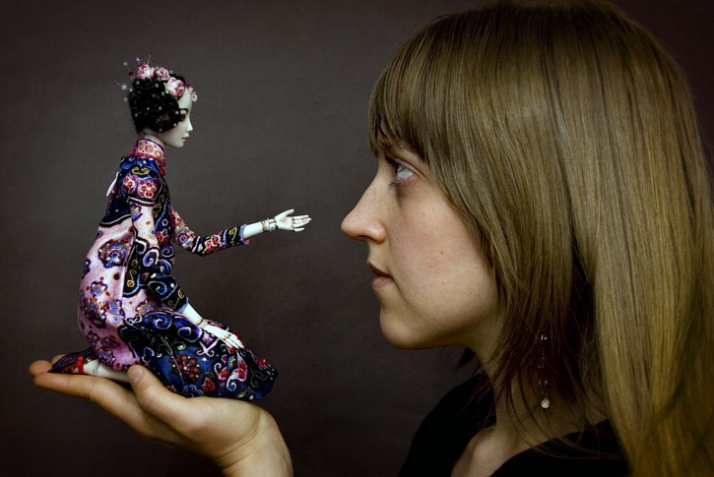
Marina Bychkova is a doll sculptor and her enchanted porcelain dolls reflect the dark and sometimes threatening undertones that classic fairy tales often contain - they are fragile and vulnerable in their beauty.
She says "I find nothing more boring and thoughtless than another girly girl doll with blond curls and a puffy dress holding a teddy bear. Ugh...!"
Follow her thoughts on twitter, visit her dolls collection at Flickr or deviantART and read carefully her beautifull interview to Jason Arber for PIXELSURGEON after the jump.
photo © Chad Isley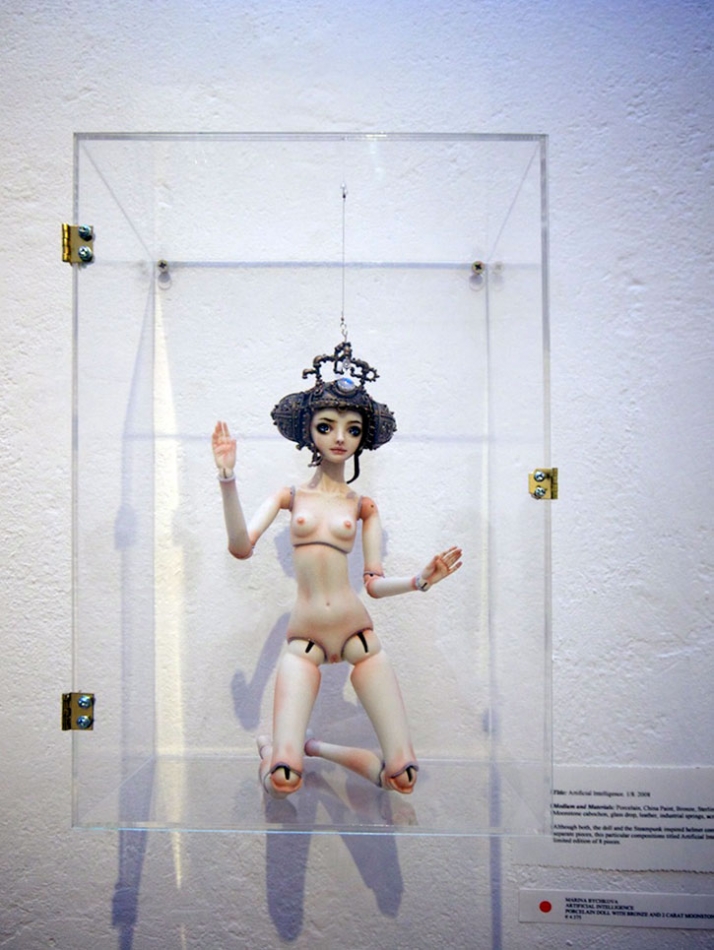
photo © Chad Isley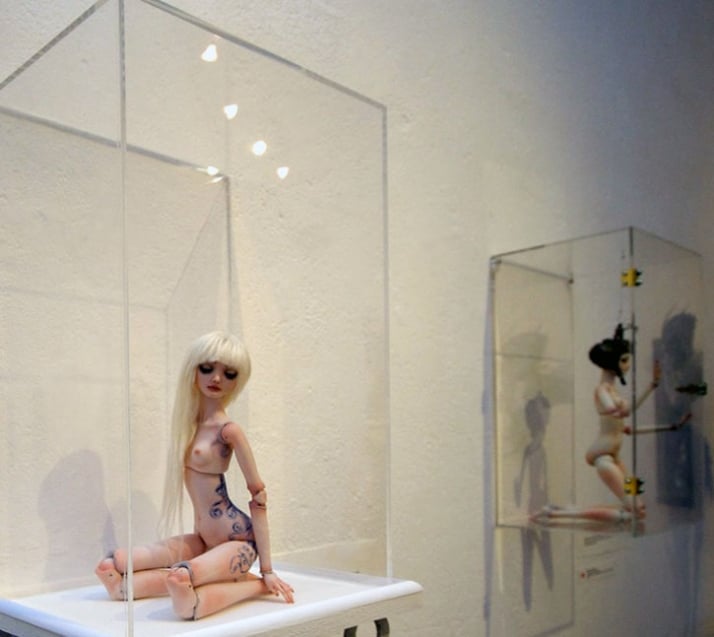
We found an interesting interview of Marina Bychkova by Jason Arber for PIXELSURGEON, and instead of making our own we decided to share it with you below.
Tell us a little bit about yourself, your upbringing and what first made you interested in dolls
I was born and lived in Siberia, Russia until I was fourteen years old. In 1997 my family immigrated to Vancouver, Canada where we’ve lived ever since. My fondest memories are of beautiful rolling hills and forests of Siberian countryside where I spent my childhood, as we lived on the outskirts of the city and had a little cottage in the county overlooking a huge river valley. The scenery alone was inspiring enough to create beautiful things but I can’t pinpoint the exact event or time which sparked my interest in dolls. It was always there as far back as I can remember, as if it was innate.
Why did you stop making dolls when you moved to Canada?
The move to Canada was an act of immense bravery on my parents’ part. Stressful, does not even begin to describe the experience. I was in culture shock for about three years, not wanting to be seen, heard or noticed. All of my energy was spent on adjusting to a new life and learning a new language.
Why did you decide to start making your dolls in porcelain?
It was a long road that took me to my current medium of choice, Porcelain, which I favor because of its remarkable properties. It is a completely stable material, resilient to UV rays, unchanging in the face of time and enduring to pretty much every other element in nature. Longevity has always been an extremely important factor for me. Maybe it’s because I’m scared of aging, but I choose the best, most durable materials for my dolls because I want to create something of such an outstanding quality that will outlive me.
Your polymer clay dolls seem less refined than your porcelain dolls; is that because you refined the technique or is it because of the materials?
Polymer Clay was a transitional material in the doll evolution. Growing up I used any material available to make dolls with, some of which were: Stalks of grass, flowers, paper, cloth, wire, screws, electrical tape, wood, parts of a shoe and my little sister’s soothers. I made hundreds of dolls. Upon discovering polymer clay in 2002 I really began practicing sculpting the correct human anatomy. It is partially due to some limitations of the medium that those first dolls are not as refined, but mostly it’s because I sucked at sculpting.
The dolls are incredibly detailed; do you need a very steady hand to paint them?
You do need a good hand to eye coordination, I guess. It’s hard on the wrists after hours and hours of tiny, precision work. Not just painting, beadwork too. I might have to start wearing wrist braces soon.
photo © Chad Isley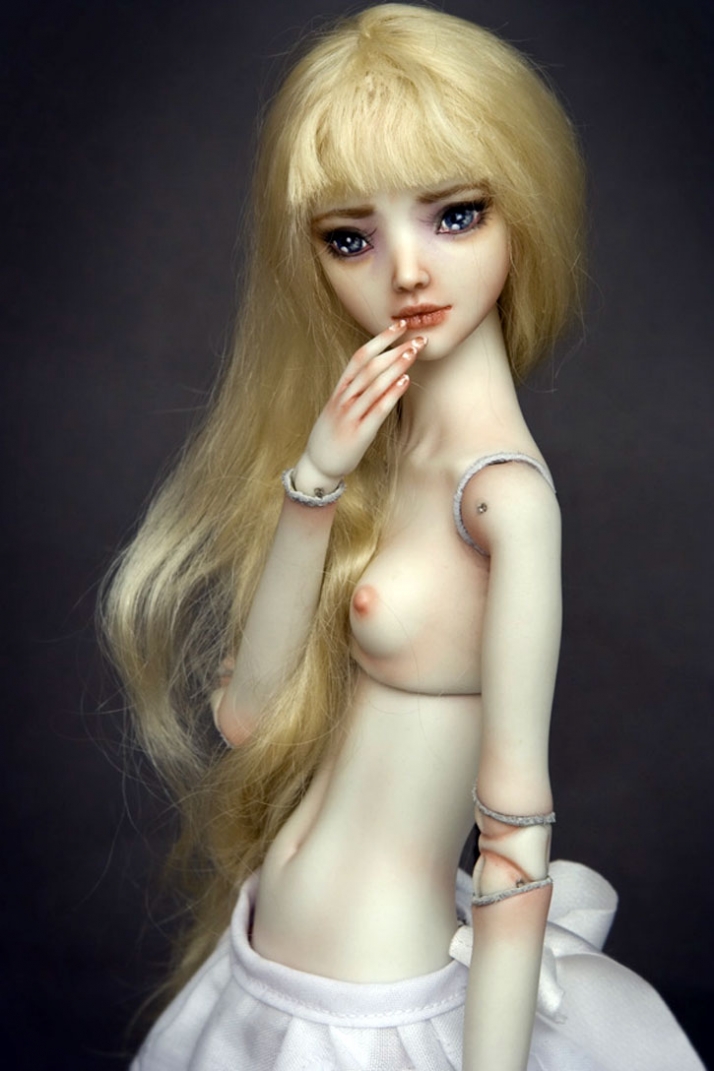
What's the step-by-step process for creating your dolls? How long does it take?
1. Sculpt 13 body pieces in polymer clay.
2. Design and test the ball joints.
3. Make molds of every piece.
4. Pour the pieces in porcelain.
5. Low fire at 1375° F
6. Clean, sand down parts
7. High fire at 2205° F
8. Sand down parts to satin finish
9. First China layer and fire
10. Second China layer and fire
Repeat this at least 2 more times
11. Glue leather into ball joints
12. String the doll with springs
13. Make costume
The process takes anywhere from 150 to 350 hours, depending on the complexity of the costume.
Your dolls are very darkly erotic; definitely not children's toys! Is the doll's sexuality an important part of their attraction for you?
The eroticism is definitely a significant element that has to be present in every doll. I suppose that says something about my personally, I’m just not sure what. It was present in all my dolls. I remember when I was, maybe six or so, I saw a picture of a painting of a beautiful naked woman in a magazine. It was explicit. I cut it out and made a doll out of it. One day my grandma discovered it. She was confiscated and destroyed with disdain. I was made feel very ashamed. I grieved for her.
The dolls are more anatomically correct than your average Barbie doll; why was it important to include detailed genitalia?
It’s compulsory. Most of the dolls, both, Fine Art and children’s dolls, though try to imitate human form, are sterilized through a complete removal of sex organs. It’s as if they need to be cleansed of all their sinful humanity. I find this deliberate denial of the essence of life to be ignorant and appalling. I don’t know why there is so much fear and shame associated with human sexuality. Every Barbie needs to have a vagina. Every Ken needs a penis. I think it’s time the dolls leave the realm of tea parties and innocence and address some important issues.
The doll's clothes are as detailed and magical as the dolls; do you make their clothes too?
I create the entire piece. I just recently finished my first two-doll composition for my graduation show at Emily Carr Institute of Art and Design. It’s a dead Snow White with a bruised neck, in a glass coffin and a Necrophiliac Prince leaning over and fondling her. That project almost cost me my sanity.
When and why did you decide to become a professional doll maker? Is it something you can make a living doing?
Wanting to make Dolls was the most constant thing in my life. The turning point was The Cinderella doll, in 2003. That’s when I found the fundamentals of a language with which to express myself. Something I always knew I wanted to say, but didn’t know how. That’s when I discovered my creative identity. As for making a living with it; I have faith in me. There is a doll market in the US, but it’s very conventional. I’m hoping to contribute something new to it by keeping some of the iconographic elements of a doll, but taking it to another level somehow. I strive for my dolls to transcend the social and traditional concepts of a doll. I want to function not as a doll maker, but as a fine artist who is dealing with dolls as a medium for further dialogue not as the sole subject matter.
photo © Chad Isley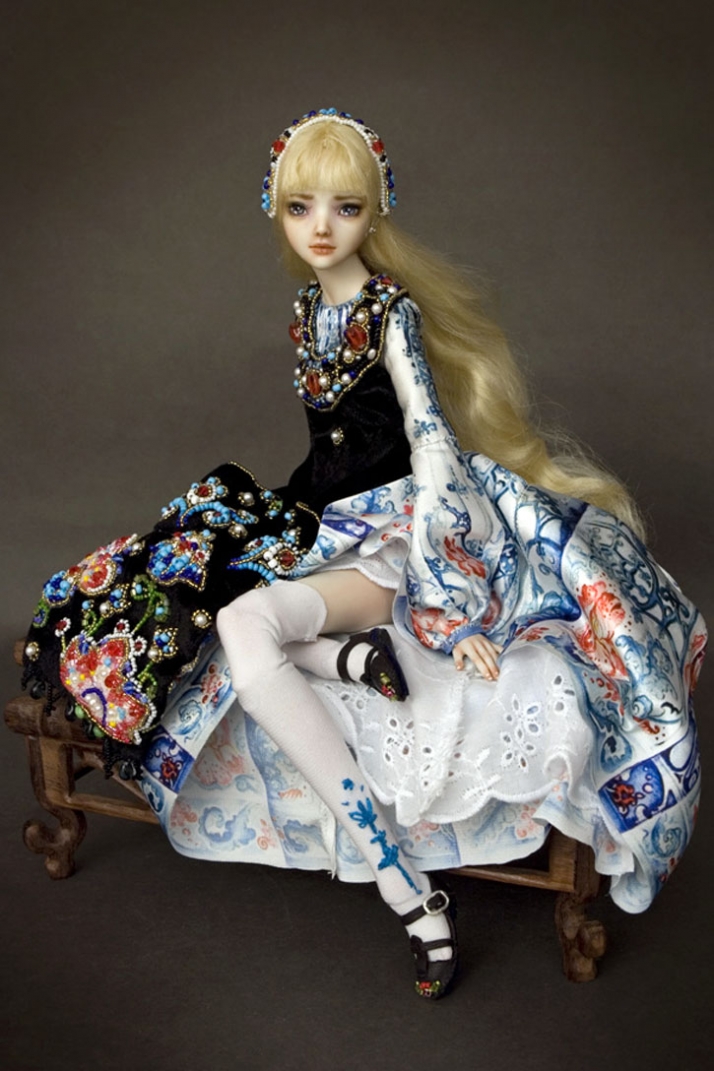
How do you choose the theme for each doll?
Well, I love fairy tales and the vast potential for a visual narrative they present. I usually store ideas in my head for months, turning them over and over before I get it down on paper. I write down the initial thought, then make more brief notes on the concept development, then several loose sketches are drawn. But due to the lengthy process of bringing the doll into being, many of the initial ideas on the project evolve and sometimes change completely.
Has your Russian upbringing had any impact on your creativity? Some of the dolls seem to have the same kind of glittering mystery that Russian Orthodox Icons have... There definitely seems to be some sultry Eastern European darkness going on, hints of Jan Svankmajer...
Of course my Russian upbringing had an impact on my creativity, it is what made me. The essence of me is still Russian. The ancient Russian Icons, the Byzantine art and fashion have been some of my major influences. The Royal jeweler Karl Fabergé is another inspiration. I strive to capture that same sense of grandeur and preciousness of miniature treasures in my dolls. With this goal in mind I had taken some jewelry courses to learn the basics of working with precious metals and gemstones. My current doll features a hand made sterling silver tiara set with Rubies, a Garnet necklace and bracelets. I’m looking forward to incorporating more metal and stone work. Next scheduled doll, will have her dress embroidered with dozens of Sapphires. Some day my dolls will wear diamonds and gold, like the Icons and the Fabergé eggs.
How would you describe your dolls?
My Children.
What has the reaction to your dolls been?
People seem to really respond to them. I’m very happy with the reactions I’ve been getting.
Will you be doing more male dolls?
Yes, male dolls are on schedule. The project that intrigues me right now is Dorian Grey, Oscar Wilde’s character from the book “The Picture of Dorian Grey”. It’ll be really challenging capturing the vanity, the beauty and the tragedy of this young man and revealing the essence of Dorian Grey in porcelain. It probably won’t happen for at least six months though.
What have you got got planned next for your dolls?
In my future projects in general I would like to continue exploring gender issues, violence and dark eroticism. I would like to create a richer visual and psychological impact. My dream is to produce something that is disturbing but breathtakingly beautiful.
Tell us a secret about yourself that until today no-one knew...
Uhh, I think my dolls are living creatures, I talk to them.
Nah, I’m just kidding. He he he. Don’t write that.
photo © Chad Isley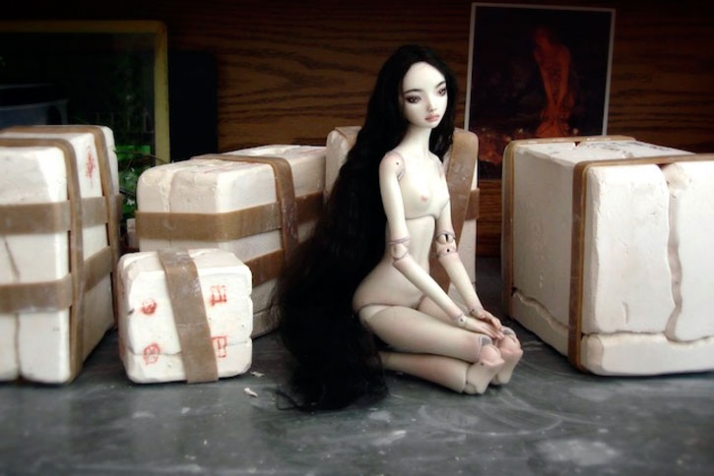
photo © Chad Isley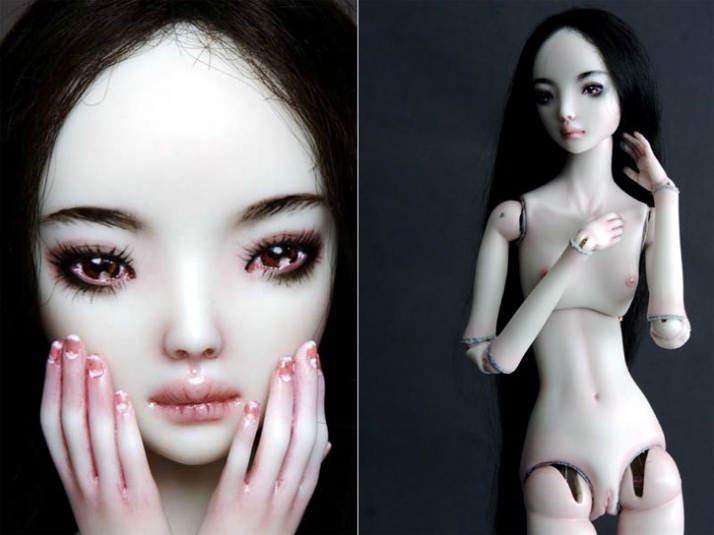
photo © Chad Isley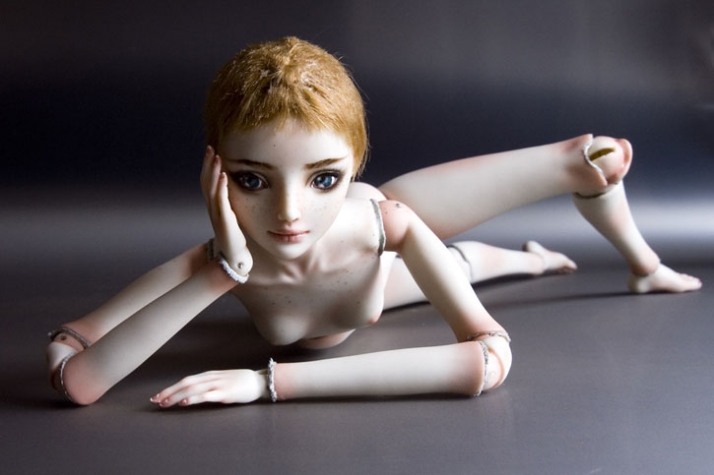
photo © Chad Isley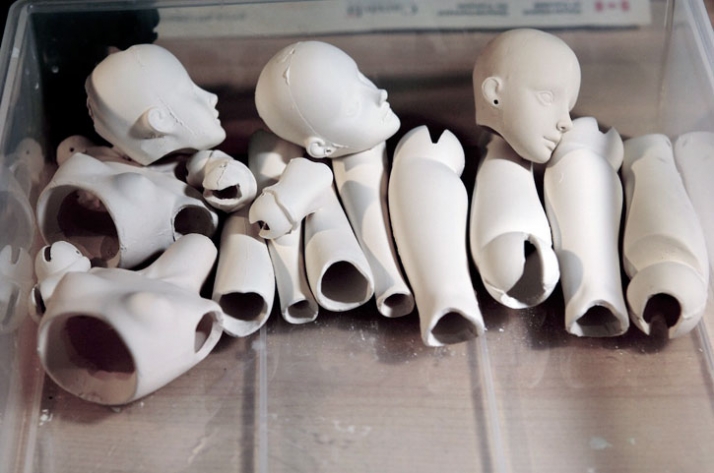
photo © Chad Isley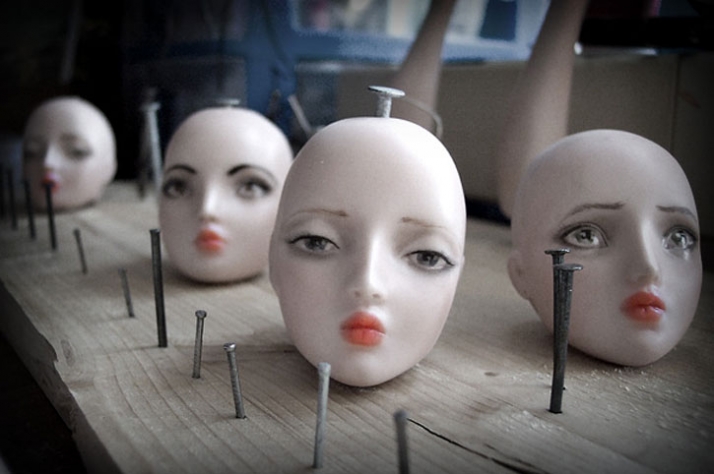
Marina Bychkova enchanted dolls will be on view from 21 January - 2 February at Strychnin Gallery in Berlin, amongst Daniel van Nes,Virginie Ropars and Cliff Wallace's artworks
Recent Articles

Palazzo Citterio: A New Chapter in Milan’s Cultural Landscape














